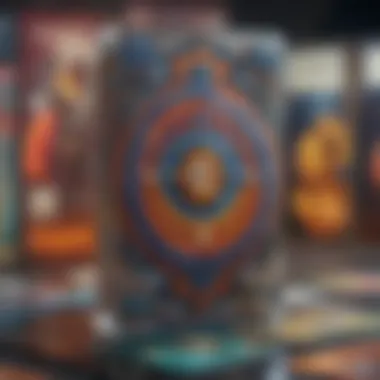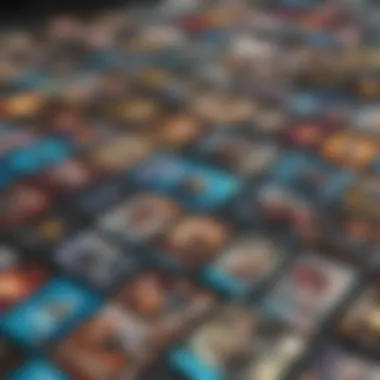Exploring the Future of Virtual Trading Cards with NFTs


Intro
The landscape of collectibles has seen an undeniable shift in recent years, with the advent of digital assets. Among these, virtual trading cards have gained immense popularity, largely driven by the integration of non-fungible tokens (NFTs). This transformation reflects a broader cultural trend where traditional values of ownership, collectibility, and investment are colliding with advancements in technology. As much as these tokens are rooted in complex systems, they also resonate on a fundamental level with collectors, investors, and enthusiasts alike. The appeal lies in the unique blend of nostalgia and innovation; followers of this phenomenon often find joy and potential profit in collecting digital representations of their favorite moments in sports, entertainment, and art.
This exploration is not merely technical. It digs into the cultural significance of digital collectibles, urging us to reconsider what we deem valuable in today’s digital age. From their genesis in blockchain technology to their market dynamics, the implications of virtual trading cards intersect various fields of art, tech, and finance, allowing for a rich tapestry of insights.
Imagine opening a virtual pack of cards, anticipating that rare find, yet knowing it exists on a blockchain forever, secure and verifiable. The connection with NFT technology not only guarantees authenticity but also shapes the very framework of how these cards are bought, sold, and cherished. In understanding the progression and potential future of virtual trading cards, one cannot ignore the pivotal role played by underlying cryptocurrency principles.
In the subsequent sections, we will unravel the foundational concepts essential to grasp the ecosystem of virtual trading cards and NFTs. Let's embark on this journey, peeling back the layers and discovering what the future holds for collectors and investors alike.
Intro to Virtual Trading Cards
In a world where technology is transforming everything we know, virtual trading cards have emerged as a compelling intersection of gaming, collecting, and digital ownership. The evolution of how we think about physical collectibles has the potential to open new avenues for interaction and investment. The immediacy and accessibility that virtual trading cards offer not only caters to a younger audience but also creates opportunities for seasoned collectors to rethink their strategies in a digital landscape. Furthermore, these virtual assets introduce unique benefits, such as real-time trading, reduced production costs, and a lower barrier to entry for new collectors.
Defining Virtual Trading Cards
Virtual trading cards are essentially digital representations of collectible cards, existing on blockchain technology, which allows for secure ownership and trading. Unlike traditional trading cards, these digital counterparts can be unique or exist in limited quantities as determined by the creator. They can represent anything from artwork to pop culture icons, and they typically come with metadata that records the history, ownership, and creation process. The allure of these cards lies not just in their digital form, but in the emotional investment and community engagement they foster among collectors.
Historical Overview
The concept of trading cards has been around since the late 19th century, originally taking shape as a marketing tool for tobacco companies. These tangible collectibles have evolved through various media, from sports memorabilia to Pokémon. Yet, it wasn't until the late 2010s that the rise of blockchain technology began nudging the norms of collectibles into the cyber realm. With the advent of Non-Fungible Tokens (NFTs), traders began digitizing their collections, thus creating virtual trading cards that not only retained their collectible nature but also gained unique attributes, like verifiable scarcity and authenticity. The crossroad of collecting and tech gives rise to wider cultural discussions about ownership and value in digital spaces.
"Virtual trading cards symbolize a blend of nostalgia and innovation, creating a new frontier in collectibles."
As we steer deeper into this technological evolution, the significance of virtual trading cards within the broader landscape of digital assets cannot be undervalued. They serve as a case study for understanding how established systems can redefine themselves through the merging of culture and technology. As this narrative unfolds, it becomes clear that the dynamics around these collectibles are about more than just the cards themselves; they touch upon changing social behaviors, economic opportunities, and future possibilities for digital expression.
Understanding NFTs
In the rapidly changing landscape of digital assets, understanding NFTs is crucial for grasping the future of virtual trading cards. Non-fungible tokens offer a unique way to represent ownership and provenance of digital collectibles, elevating conventional trading practices into the realms of the blockchain. This section will explore the mechanics and distinctive traits of NFTs that not only change how we perceive ownership but also how we interact with digital art and collectibles.
The Mechanics of Non-Fungible Tokens
At their core, NFTs are a mix of cryptographic technology and blockchain functionality. Unlike cryptocurrencies, such as Bitcoin or Ethereum, NFTs are non-interchangeable. Each token holds a distinct value and cannot be exchanged on a one-to-one basis. This characteristic stems from their unique identifiers and metadata stored on the blockchain, which offers a transparent and secure ledger of ownership.
The process usually begins with the creation, or minting, of an NFT, which can be done by artists or creators using platforms like OpenSea or Rarible. They upload their digital work, whether it’s art, music, or virtual trading cards, and create a token that reflects their unique piece. After this, buyers can purchase these NFTs through smart contracts that automate the transaction, guaranteeing that all involved parties fulfill their obligations without need for intermediaries.
Blockchain technology is often compared to a public library, where every transaction is recorded as an entry in a catalogue, making it easy for anyone to trace the history of an asset.
These digital assets are often bought and sold through online marketplaces that support the ERC-721 token standard for NFTs. This standard ensures that each token is one-of-a-kind and lays the groundwork for vibrant trading ecosystems around virtual collectibles.
Distinct Features of NFTs
Several key features distinguish NFTs from traditional digital files and other digital assets:


- Indivisibility: Unlike cryptocurrencies, which can be broken into smaller units, NFTs cannot be divided. Each one remains complete and integral.
- Authenticity: Ownership and authenticity are assured through the blockchain. Each transaction is chronologically documented, making verification straightforward.
- Interactivity: Many NFTs integrate multimedia elements. This means digital art, music, or virtual trading cards can incorporate experiences beyond mere ownership, enhancing user engagement.
- Programmability: Smart contracts allow creators to encode royalty terms directly into the NFT. This feature ensures that artists receive a percentage of future sales, promoting ongoing revenues.
The End of the Section
Understanding NFTs is pivotal for comprehending the broader implications of virtual trading cards in the digital marketplace. As these tokens continue to evolve, they reflect changes in technology, culture, and commerce, hinting at a new era where digital assets are coveted in ways we’ve yet to fully explore.
The Intersection of Virtual Trading Cards and NFTs
The relationship between virtual trading cards and NFTs represents a convergence of technology, culture, and commerce that is reshaping how we think about collectibles. This section dives into that intersection, focusing on what’s at stake and the potential benefits that arise from this unique pairing.
Tokenization of Digital Assets
Tokenization is the primero step in transforming virtual trading cards into NFTs. Simply put, tokenization is the process of turning something tangible or intangible into a digital token on a blockchain. With virtual trading cards, this means taking an image or a digital representation of a card and linking it to an NFT that proves ownership and authenticity.
This method presents numerous advantages:
- Ownership Transparency: The blockchain provides a transparent ledger, meaning every transaction is publicly recorded. This contributes significantly to verifying authenticity, crucial in a market susceptible to counterfeits.
- Scarcity and Value: Just like physical collectibles, digital cards can be created in limited editions. This scarcity can drive demand, elevating the value of certain cards in the eyes of collectors.
- Programmable Features: NFTs allow for the inclusion of unique attributes via metadata. These features can outline rarity, special abilities, or historical significance, enriching the narrative of each card far beyond what traditional cards can offer.
By utilizing tokenization, collectors are not just buying cards; they are investing in unique digital assets with clear provenance. This adds a layer of significance not easily achieved in physical counterparts.
Smart Contracts in Trading
Smart contracts serve as self-executing contracts with the agreement directly written into code. In the realm of virtual trading cards, they bring an entirely new dimension to trading and ownership.
For instance, smart contracts can automate processes such as:
- Royalty Payments: Whenever a card is resold, smart contracts can ensure that the original creator receives a percentage of the sale automatically, perpetuating income from their intellectual property.
- Dynamic Ownership Transfers: Unlike physical cards that require manual transfer, smart contracts facilitate seamless ownership changes. This means a buyer can instantly receive the NFT upon purchase without the need for intermediaries.
- Conditioning Trades: Some smart contracts can implement conditions on trades, stipulating that a card can only be sold if certain parameters are met, such as maintaining a minimum price.
This automation reduces transaction costs and enhances the trustworthiness of the trading process. Likewise, it fosters a richer trading environment where creators, collectors, and traders alike can operate under a system that inherently rewards engagement and creativity.
"The integration of smart contracts and tokenized assets represents the future of not only trading cards but digital ownership in general."
In summary, the interplay between virtual trading cards and NFTs is more than just a trend; it's a transformative evolution that leverages the benefits of technology to redefine ownership and value in the digital age.
Market Dynamics of Virtual Trading Cards as NFTs
The realm of virtual trading cards has taken on a new dimension with the introduction of non-fungible tokens (NFTs). This convergence creates a vibrant market dynamic, impacting collectors, investors, and creators alike. Understanding these dynamics is crucial for those involved in this innovative sector, as they navigate through its unique landscape.
Emerging Trends in Collectibles
When you look at the current landscape of collectibles, a few trends begin to pop up like daisies in spring. One significant trend is the growing appeal of limited editions. People are flocking toward digital assets that offer a sense of exclusivity. In that sense, what’s more appealing than a rare digital card that only a select few can own? Collectors are increasingly drawn to the idea of scarcity and uniqueness, making limited edition virtual cards hot commodities.
Additionally, there's been a noticeable shift toward user-generated content. Platforms that allow users to create their own cards, similar to creating memes or custom skins in video games, are gaining traction. For instance, platforms like Sorare enable football fans to craft their own fantasy leagues through virtual trading cards of real-life players, blending the worlds of sports and gaming seamlessly.


Conversely, we also see collaborations between well-known brands and artists, creating cards that hold artistic merit as well. This cross-pollination of creativity brings fresh air into the collectibles market, generating buzz and excitement. Collectors no longer just seek cards for nostalgia; they also look for those that resonate culturally or artistically. The dimension of storytelling is being brought to the fore here, as each card can tell a tale that speaks to the owner's passion—whether it's comic art or sports history.
Pricing Models and Valuation
Understanding pricing models in the context of virtual trading cards takes a bit of digging. Unlike traditional collectibles, which may rely on physical condition and rarity, pricing for NFTs hinges on a couple of nuanced factors. One prominent model is the auction mechanism, where cards go to the highest bidder. Just like at an estate sale, emotions and competition can drive prices sky high, particularly for coveted items.
Another critical factor influencing prices is the utility of the NFT. Cards that can be used in games or provide some in-game benefits tend to hold greater value. This intrinsic utility enhances their worth as something beyond just artistry or nostalgia.
Market speculation also plays a vital role. Investors often try to predict which new cards or series will gain traction in the future. For instance, early adopters of certain gaming franchises saw their investments pay off handsomely, as specific trading cards appreciated dramatically in value over time.
In terms of valuation, platforms like OpenSea provide analytics tools that help buyers and sellers gauge the market, offering insights into trends and average sale prices. However, it's essential to remember that the virtual trading card market can often mimic the whims of the cryptocurrency market; volatility is not just a buzzword but a reality.
"The uniqueness of NFTs creates a collector's paradise, but navigating their value can often feel like trying to catch smoke with your bare hands."
In summary, the market dynamics of virtual trading cards as NFTs reflect growing trends that fuse art, technology, and commerce. Collectors are not just acquiring card; they are investing in stories, culture, and future market potentials. Understanding these elements can certainly provide an edge in this thriving, if unpredictable, market.
Cultural Impact of Virtual Trading Cards
The emergence of virtual trading cards is not merely a digital fad; it marks a significant cultural transformation. Their rise intertwines with advancements in technology, shifting consumer behavior, and the evolving landscape of collectibles. Understanding their cultural impact enables us to grasp how these assets fit into our broader societal narrative.
Community Building Around Collectibles
The virtual trading card space has birthed vibrant communities where collectors unite. These groups often form around shared interests, whether it’s a passion for a particular game or nostalgia for a franchise. Platforms like Reddit and Discord serve as bustling hubs where enthusiasts exchange tips, trade cards, and discuss strategies. It’s no stretch to say that these communities foster a sense of belonging, akin to traditional enthusiast clubs that existed in physical spaces.
Moreover, community-driven initiatives often lead to events such as virtual meetups, tournaments, and exclusive showcases. Participants are not just passive consumers; they become active contributors, shaping the narrative of the trading card universe. Their participation helps to imbue the cards with value beyond monetary terms, creating social capital.
"In a digital age, connecting through shared passions has never been easier. Collectors find identity and camaraderie through their virtual interests."
Influence of Online Platforms
Online platforms play a pivotal role in shaping the cultural dynamics of virtual trading cards. Services like Facebook and Instagram allow users to showcase their collections, facilitating a culture of sharing and visibility. The artistic aspects of these cards can often lead to discussions about design, rarity, and thematic relevance, effectively merging art and commerce.
Additionally, these platforms serve as stages for influencers and collectors to promote unique drops, limiting editions, and exclusive auctions. News spreads like wildfire, with traders flocking to acquire new items that could enhance the collective experience. In this sphere, the popularity of a card can hinge on social media mentions just as much as intrinsic qualities.
The result is a multi-faceted ecosystem where cards become not just collectibles, but symbols of identity, reputation, and status among peers. Understanding this dimension highlights the significance of virtual trading cards in today’s culture, paving the way for their sustained evolution.
Challenges in the Virtual Trading Card Market
The world of virtual trading cards, particularly those tied to blockchain technology through non-fungible tokens (NFTs), isn't all rainbows and sunshine. While they present fascinating opportunities for collectors and investors alike, there are several hurdles that participants must navigate.
One key area of concern is fraud and security. With the rise of digital assets, bad actors lurk in the shadows, keen to exploit unsuspecting users. In this digital landscape, the nature of virtual trading cards makes them susceptible to various fraudulent activities. Here, collectors might find themselves dealing with issues ranging from counterfeit NFTs to phishing scams that aim to siphon sensitive information. Owners of virtual trading cards should take careful steps to secure their wallets and transactions. Ensuring the authenticity of cards and being vigilant when engaging on peer-to-peer platforms is paramount.
But that’s not all. As digital economies evolve, the regulatory landscape remains a tangled web. Laws and regulations surrounding NFTs and virtual collectibles are often murky, with lawmakers struggling to catch up with this fast-paced digital frontier. As different countries grapple with how to classify these assets — will they be treated as currency, property, or something else entirely? — this uncertainty can create a muddle for buyers and sellers alike. Collectibles that are popular today could find themselves under revised scrutiny tomorrow, posing a risk to both investment and ownership rights.


"The challenge of creating a secure and clear regulatory framework is paramount for the credibility and long-term viability of virtual trading cards as real assets."
To summarize, the virtual trading card market sits at a crossroads of innovation and caution. While fraud and security concerns demand ongoing attention, the brackish waters of regulation require continuous monitoring as well. As NFT collectors and traders engage with this budding landscape, understanding these challenges is as vital as recognizing the potential.
Through these challenges, it’s clear that stakeholders in the virtual trading card realm will need to stay alerted, informed, and proactive in their dealings to foster a safe and sustainable environment for this exciting new form of collectible.
Future Directions for Virtual Trading Cards
The future of virtual trading cards is not just a fleeting buzzword; it's rapidly becoming a multi-faceted ecosystem that combines nostalgia with state-of-the-art technology. As digital engagement deepens, the significance of this topic extends beyond mere entertainment, touching upon economic opportunities, community dynamics, and artistic expression. Understanding the potential pathways ahead helps investors, tech professionals, and collectors grasp the evolving landscape.
Technological Innovations on the Horizon
Innovation is the cornerstone of change. The virtual trading card space is ripe for technological advancements that aim to enhance user experience and streamline transactions. For instance:
- Augmented Reality (AR): Imagine not only having digital cards but experiencing them in your physical space via AR technology. Engaging users on a new level, AR can elevate interactions by adding layers of information or interactivity to the cards. A dual-reality experience could bridge the gap between the tactile and the virtual, making collecting immersive.
- Enhanced Security Features: As the market grows, the importance of security cannot be understated. Blockchain technology is already at the heart of NFTs, but employing advanced cryptography could safeguard ownership and authenticating transactions even further. Integrating biometric verification could ensure that the true owner retains control over their assets.
- AI for Personalization: Artificial intelligence is set to play a crucial role in curating user experiences. Whether it’s suggesting cards based on past purchases, analyzing market trends to identify valuable assets, or even creating unique, personalized trading cards, AI could reshape how users engage with their collections.
These innovations are crucial not only for attracting new collectors but also for retaining current users, who expect a seamless, engaging experience.
Potential for Interoperability
Interoperability is a term gaining traction in the digital ecosystem. In simple terms, it refers to the ability of various platforms and technologies to communicate with one another. In the virtual trading card domain, this could be groundbreaking.
- Cross-Platform Compatibility: The ability for users to trade cards across different platforms can enhance community interaction. If my virtual collection can easily be showcased on a gaming platform, a social media site, or a digital art gallery, the opportunities for visibility and trade multiply exponentially.
- Unified Wallets: Imagine managing a collection using a single digital wallet that accommodates various card types and formats, whether they be part of a game, a collectible, or an art piece. Unified wallets could simplify transactions and provide easier access to trading for collectors.
- Shared Ecosystems: An interconnected marketplace could allow for greater fluidity in trading. Collaborations between different NFT marketplaces can provide a larger audience for trading cards, enabling collectors to connect more efficiently.
Interoperability isn't just about technical capabilities; it's about creating a cohesive experience for users, where limitations fade away and opportunities prosper.
"The digital age necessitates not just innovation but also harmonization across platforms. The success of virtual trading cards will rely on community and technology working hand-in-hand to create an enriching experience for all involved."
Through exploring these future directions, we see a landscape filled with potential. Embracing technological advancements and striving for interoperability will not only enhance the experience for collectors but also solidify virtual trading cards as a staple in the evolving world of digital assets.
Finale
The exploration of virtual trading cards through NFTs brings to light nuanced insights into the future of digital collectibles. This section aims to crystallize the key takeaways and offers a glimpse into the potential paths forward for these innovative assets.
Summarizing Key Insights
As we wrap up the discussion, it’s clear that virtual trading cards, powered by non-fungible tokens, fundamentally reshape our understanding of ownership in the digital realm.
- New Ownership Models: NFTs introduce a unique way of proving ownership, ensuring no two digital assets are identical. This uniqueness elevates virtual trading cards beyond mere images or files to something much more valuable.
- Cultural Significance: We are witnessing a shift in how collectables are viewed. No longer are trading cards confined to physical boxes. They now provide an online community and cultural dynamics that were almost unheard of before.
- Economic Implications: With growing investments pouring into this market, understanding pricing models, and factors that influence valuations have become crucial for collectors and investors alike. The market's volatility can resemble that of cryptocurrencies, introducing both risks and rewards.
In summary, the intersection of technology and culture surrounding virtual trading cards presents an alluring new frontier for collectors and investors. There’s much to gain from keeping a keen eye on this evolving landscape.
A Vision for Future Collectibles
Looking ahead, the future of virtual trading cards appears vibrant and bustling with potential.
- Interoperability Possibilities: As platforms evolve and the technology matures, the idea of interoperability may come to fruition. Imagine trading a card from a popular game on one platform to be used in another.
- Enhanced User Experience: Developments in augmented reality and virtual reality could provide more immersive experiences. Picture having a virtual exhibition of your own card collection where others come to view and trade.
- Mainstream Adoption: Also, as awareness grows, more traditional collectors may embrace this shift. Large companies or franchises could tie their brand to unique NFT trading cards, blending traditional fandom with cutting-edge tech.
The potential is far-reaching. As these trends gear up, stakeholders in this domain should remain agile, responding to shifts in technology and market behaviors.
Adapting to changes and embracing new ideas will position investors, collectors, and creators at the forefront of this exciting journey into the future of virtual trading cards.



